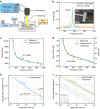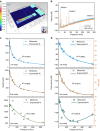Thermal noise-driven resonant sensors
- PMID: 38938527
- PMCID: PMC11208434
- DOI: 10.1038/s41378-024-00718-0
Thermal noise-driven resonant sensors
Abstract
MEMS/NEMS resonant sensors hold promise for minute mass and force sensing. However, one major challenge is that conventional externally driven sensors inevitably encounter undesired intrinsic noise, which imposes a fundamental limitation upon their signal-to-noise ratio (SNR) and, consequently, the resolution. Particularly, this restriction becomes increasingly pronounced as sensors shrink to the nanoscale. In this work, we propose a counterintuitive paradigm shift that turns intrinsic thermal noise from an impediment to a constituent of the sensor by harvesting it as the driving force, obviating the need for external actuation and realizing 'noise-driven' sensors. Those sensors employ the dynamically amplified response to thermal noise at resonances for stimulus detection. We demonstrate that lightly damped and highly compliant nano-structures with high aspect ratios are promising candidates for this class of sensors. To overcome the phase incoherence of the drive force, three noise-enabled quantitative sensing mechanisms are developed. We validated our sensor paradigm by experimental demonstrating noise-driven pressure and temperature sensors. Noise-driven sensors offer a new opportunity for delivering practical NEMS sensors that can function at room temperature and under ambient pressure, and a development that suggests a path to cheaper, simpler, and low-power-consumption sensors.
Keywords: Electrical and electronic engineering; Sensors.
© The Author(s) 2024.
Conflict of interest statement
Competing interestsThe authors declare no competing interests.
Figures




References
LinkOut - more resources
Full Text Sources
